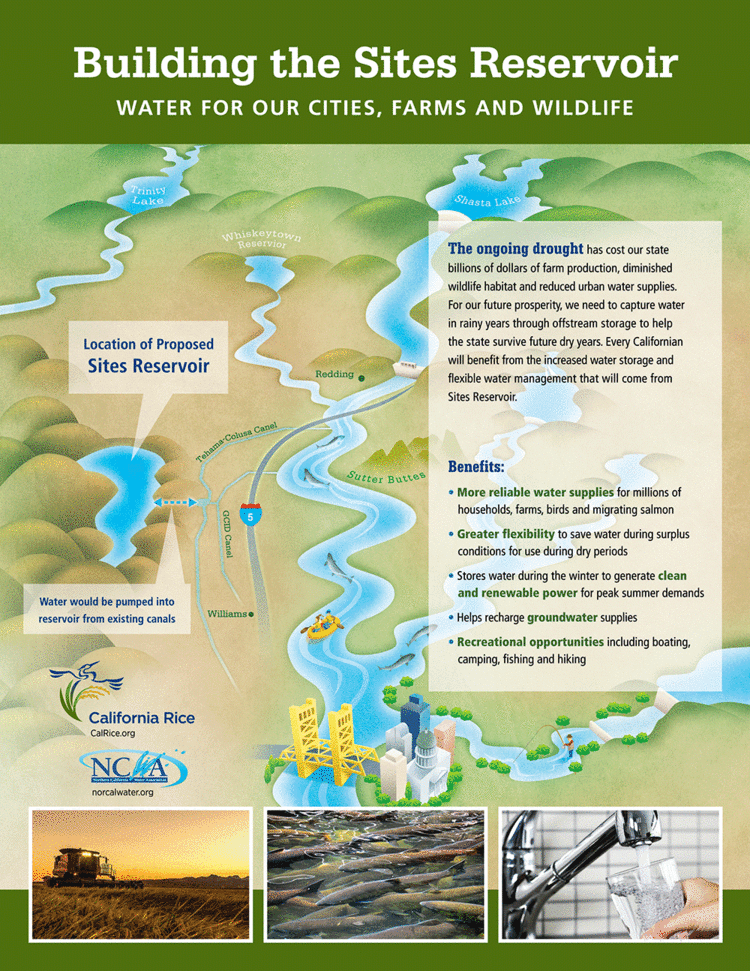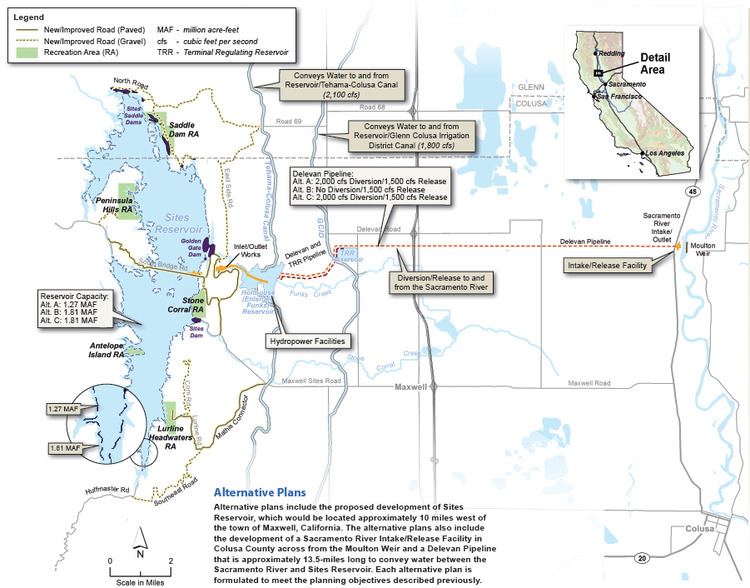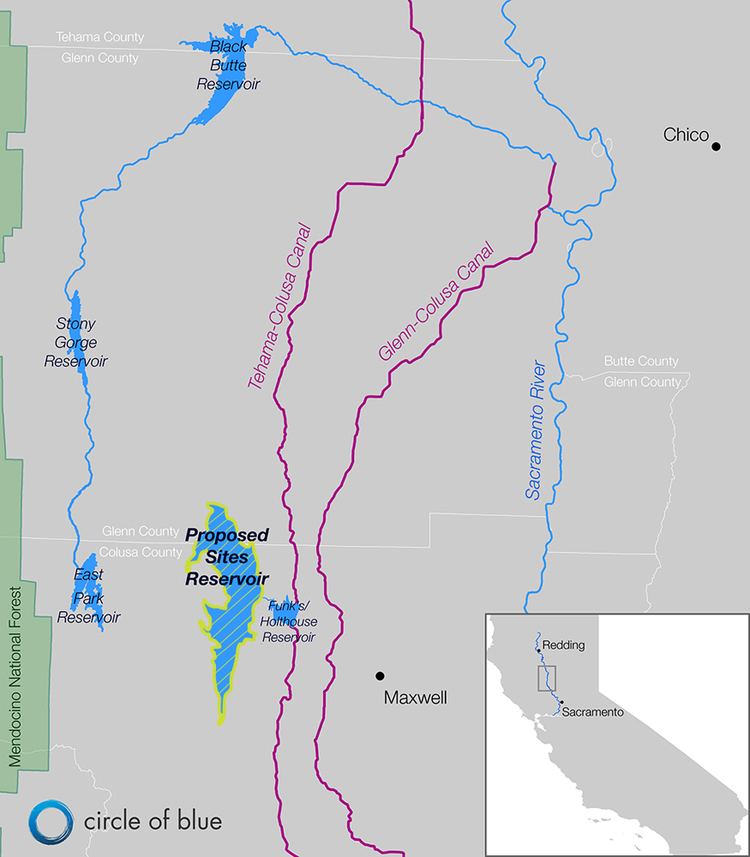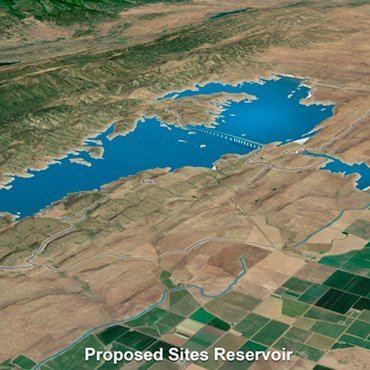Type Offstream reservoir Max. length 13 miles (21 km) Area 56.66 km² Length 20.9 km | Built Proposed Max. depth 310 ft (94 m) Surface elevation 177 m Water volume 2.233 km³ | |
 | ||
Primary outflows Stone Corral Creek, Funks Creek Surface area 14,000 acres (5,700 ha) Managing agency | ||
Sites reservoir would boost california water supply
The proposed Sites Reservoir would be a large offstream reservoir in the Sacramento Valley in Northern California, a project of the California Department of Water Resources. Its primary purpose is to collect winter flood flows from the Sacramento River, diverting the water upstream of the Sacramento–San Joaquin River Delta and pumping it into an artificial lake located west of Colusa. The estimated water yield would be between 470,000 to 640,000 acre feet (580,000,000 to 790,000,000 m3) per year, depending on yearly rainfall and environmental regulations.
Contents
- Sites reservoir would boost california water supply
- Sites reservoir 101 part one
- HistoryEdit
- SpecificationsEdit
- Potential environmental impactsEdit
- References

The reservoir would be operated as part of the California State Water Project (SWP) and is projected to cost between $2.3–3.2 billion. According to a 2013 Bureau of Reclamation study, it would provide economic benefits of between $248.8–276.2 million per year, while annual operating costs would be in the range of $10–20 million.

The state Department of Water Resources received an approval to study water storage north of the delta in 1996, and more funding was approved every several years since then. As of 2014, $52 million has been spent on studies.

Sites reservoir 101 part one
HistoryEdit
The first proposals for Sites appeared in the 1980s as part of the State Water Project's Stage II. Stage I, which comprised the project's primary features, including the Oroville Dam, California Aqueduct and associated hydroelectric plants and pumping stations, was completed during the 1960s to mid-1980s, to provide an annual water yield of 2.23 million acre feet (2.75 km3). Stage II, which included Sites Reservoir, the Peripheral Canal and various proposals to divert other Northern California rivers was intended to bring the SWP to its full yield of 4 million acre feet (4.9 km3). Due to political and environmental opposition, these projects have not been built. Sites Reservoir went through federal review in 1996 but did not receive authorization.

However, the 21st century has experienced a growing threat of serious water shortfalls due to drought and rapid population growth in California; by 2020 the annual deficit of supply to demand could be as much as 3 million acre feet (3.7 km3). Current studies refer to the reservoir officially as the North-of-Delta Offstream Storage Project. The DWR has noted that between 2002 and 2011, SWP water supply delivery reliability declined, and that NODOS could improve water supply reliability during drought periods (when operated in conjunction with existing reservoirs).
SpecificationsEdit

The 14,000-acre (5,700 ha) reservoir would be formed by several dams located in the east foothills of the California Coast Ranges, flooding the long and narrow Antelope Valley. The main dams, Sites and Golden Gate, would be built across Stone Corral and Funks Creeks, respectively; the larger of the two, Sites, would stand about 310 feet (94 m) high. Six smaller saddle dikes would hold in the north end of the lake. The total capacity would be between 1.27 to 1.81 million acre feet (1.57 to 2.23 km3), which could be further expanded in the future by raising the surrounding dikes. Up to 5,900 cubic feet per second (170 m3/s) of water would be supplied to the reservoir via the existing Tehama-Colusa and Glenn-Colusa Canals as well as a new pumping station on the Sacramento River.
Sites would be operated as a pumped-storage hydroelectric plant, similar to San Luis Reservoir in Central California's San Joaquin Valley, and as a result would be a net power consumer. However, a hydroelectric power plant here would help in the generation of peaking power for the Northern California grid.
Potential environmental impactsEdit
Unlike other proposed reservoir projects in California, Sites would not directly affect fish migration because it is not located on a major river, and could be a source of additional cold water for fall-run chinook and coho salmon.
However, diversions could take more than 60 percent of the Sacramento's flow at certain times, with potential harm to salmon and other migrating fish. The reservoir itself would affect habitat for 23 sensitive, threatened or endangered wildlife species. The exposed location would also cause the annual evaporation of about 30,000 acre feet (37,000,000 m3) of water.
The project would be operated in the interest of protecting fisheries, with such installations proposed as advanced fish screens at the pumping stations along the Sacramento River; potential modifications to upstream Shasta Dam to increase the supply of cold water available there; and modifications to the existing Tehama-Colusa and Glenn-Colusa Canal intakes that would be used by the project.
